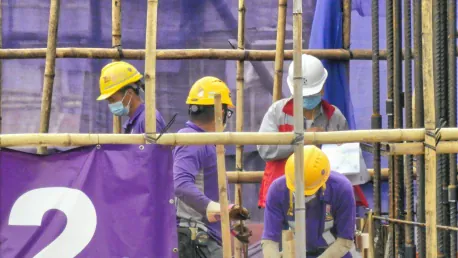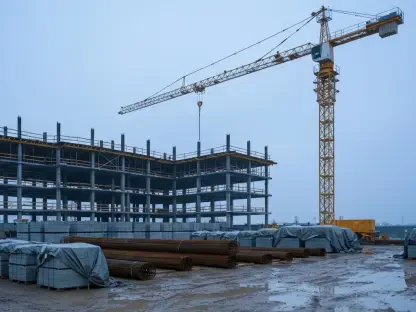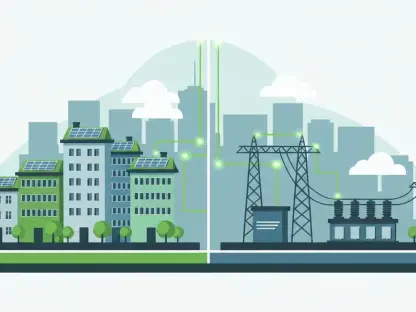Despite a volatile market and looming uncertainties, construction employment has shown a positive trend over recent years, with significant growth recorded in various states. As the construction industry adapts to changing economic and policy landscapes, stakeholders are vigilant about the sustainability of these employment gains. The latest data from the Associated General Contractors of America (AGC) paints a complex picture, indicating both promising growth and potential challenges ahead.
Construction Employment Trends
Positive Growth and Key Contributors
Construction employment increased in 31 states and the District of Columbia over the previous year, highlighting a positive trajectory within the industry. Texas emerged as a major contributor to this growth, adding an impressive 21,700 jobs, while New Mexico displayed the highest percentage increase at 12.2%. Other noteworthy states with substantial job additions included Florida, Ohio, Idaho, and North Carolina, signaling robust activity in these regions.
The report underscores that despite these gains, fluctuations in monthly employment figures hint at underlying market uncertainties. Between January and February of this year, 27 states and D.C. continued to add construction jobs, showcasing resilience in the face of economic challenges. Ohio led the monthly job gains, reinforcing its position as a pivotal player in the industry’s employment landscape.
However, these promising figures are juxtaposed with a degree of caution. Experts within the construction sector are closely monitoring various external factors that could influence future employment trends. Tariffs, international trade relations, and immigration policies are among the key elements contributing to this uncertainty, as they carry the potential to disrupt supply chains and labor availability. Understanding and navigating these complexities remains essential for maintaining employment growth in the construction industry.
Impact of Economic and Policy Factors
The construction industry faces an array of economic and policy factors that present both opportunities and challenges. The potential impact of tariffs and reactions from international trading partners could reshape the cost dynamics of materials and resources vital to construction projects. This, in turn, might influence hiring patterns and employment stability within the sector. Similarly, possible work authorization cancellations for foreign workers add another layer of complexity to workforce management, emphasizing the need for strategic planning to mitigate disruptions.
While Texas celebrated the highest employment increase, California saw the largest decline over the past year, shedding 14,900 construction jobs. Washington, Arizona, New York, and Massachusetts also experienced notable losses, with Montana recording the highest percentage drop at 6.4%. Concerning monthly changes, Washington led job losses in February, underscoring regional disparities in employment trends.
Industry stakeholders like the AGC recognize these dynamics and are advocating for proactive measures. Increased funding for domestic construction education and training programs is one such strategy contemplated to secure a skilled workforce capable of meeting future demands. Expanding lawful entry opportunities for foreign workers is another avenue to ensure the industry retains access to a diverse pool of talent. AGC’s CEO, Jeffrey Shoaf, emphasizes the necessity for collaboration with policymakers to build a robust and sustainable workforce infrastructure.
Navigating Future Challenges
Strategic Workforce Planning
As the construction sector grapples with evolving economic and policy landscapes, strategic workforce planning becomes pivotal. AGC’s advocacy for enhanced domestic education and training programs reflects a forward-thinking approach aimed at bolstering the industry’s capacity to adapt and thrive. Developing a skilled labor force equipped with the latest technical competencies is crucial for sustaining employment growth and driving productivity in the face of uncertainties.
Expanding lawful entry opportunities for foreign workers also plays a fundamental role in this strategy. By prioritizing immigration policies that support the construction workforce, the industry can address labor shortages and maintain operational continuity. Collaborative efforts with the administration to secure a future workforce for high-paying construction careers are essential steps toward mitigating potential disruptions and ensuring long-term stability.
Addressing Regional Disparities
Regional disparities in construction employment underscore the necessity for tailored solutions to address unique challenges faced by different states. California’s significant job losses require targeted interventions to alleviate the impact on local economies and communities. Similarly, states with notable employment gains must continue to foster conditions conducive to sustained growth, focusing on factors such as infrastructure investment and supportive regulatory environments.
Ohio’s recent leadership in monthly job gains exemplifies the positive outcomes of strategic workforce planning and regional collaboration. By learning from successful states and implementing best practices across the board, the construction industry can work towards balanced and sustainable employment growth nationwide. Continuous monitoring of employment trends and proactive measures will be critical in navigating the evolving landscape and ensuring the industry’s resilience.
Future Considerations for Construction Employment
Amid a turbulent market and upcoming uncertainties, employment in the construction sector has trended positively over recent years. Various states have recorded notable growth, showcasing the industry’s resilience and adaptability to shifting economic and policy environments. Stakeholders in the construction sector remain watchful about the durability of these employment gains as the landscape continues to evolve. Recent data released by the Associated General Contractors of America (AGC) presents a nuanced view, pointing to both promising growth and potential hurdles that lie ahead. As the industry navigates these complexities, it remains focused on sustaining progress while addressing the challenges that may impede future growth. Stakeholders are particularly attentive to regulatory changes, supply chain issues, and workforce development. Overall, while the current outlook shows optimism, a mindful approach is essential to ensuring the long-term stability and growth of construction employment across the nation.









